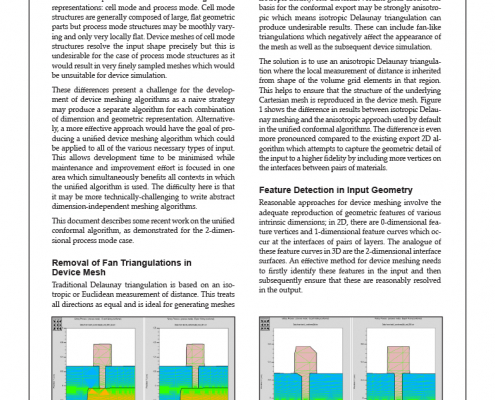
Unified Victory Conformal Export for 2D Process Mode
Victory Process can operate in either 1, 2 or 3-dimensions and can produce one of two different geometric representations: cell mode and process mode. Cell mode structures are generally composed of large, flat geometric parts but process mode structures may be smoothly varying and only very locally flat. Device meshes of cell mode structures resolve the input shape precisely but this is undesirable for the case of process mode structures as it would result in very finely sampled meshes which would be unsuitable for device simulation.
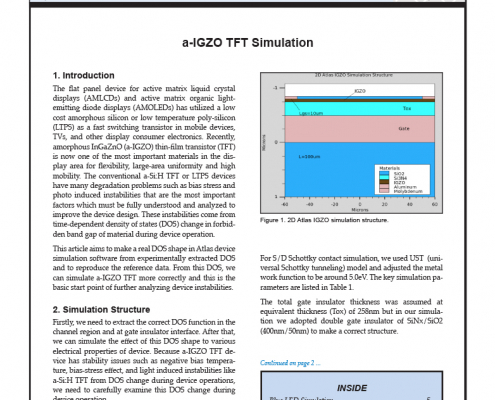
a-IGZO TFT Simulation
The flat panel device for active matrix liquid crystal displays (AMLCDs) and active matrix organic light-emitting diode displays (AMOLEDs) has utilized a low cost amorphous silicon or low temperature poly-silicon (LTPS) as a fast switching transistor in mobile devices,TVs, and other display consumer electronics. Recently, amorphous InGaZnO (a-IGZO) thin-film transistor (TFT) is now one of the most important materials in the display area for flexibility, large-area uniformity and high mobility. The conventional a-Si:H TFT or LTPS devices have many degradation problems such as bias stress and photo induced instabilities that are the most important factors which must be fully understood and analyzed to improve the device design. These instabilities come from time-dependent density of states (DOS) change in forbidden band gap of material during device operation.

Hints, Tips and Solutions – Crop and Slice using a non-convex mask in Victory Process export
Q. How can I Crop and Slice using a non-convex mask during the export?
Non-Convex Mask Polygons
Non-Convex Mask Polygons
Previous Victory Process releases have supported convex polygon cropping, slicing and mirroring support. It is also now possible to use non-convex polygons for either cropping or slicing.
In Figure 1 an example of a non-convex polygon crop and slice in the cell mode victory (delaunay) export is given. Note that the deck syntax is identical to the convex case.
2D Crop, Slice and Mirror
It is possible to perform the crop, slice and mirror (process and/or device) in the 2D exports.
An example of this functionality is given in Figure 3, where a crop and slice is shown. It should be noted that the coordinates specified in the polygon mask are those in the 2D export and not the 3D grid that the export is taken from (i.e., only X/Y need to be specified even though this cutplane is XZ).
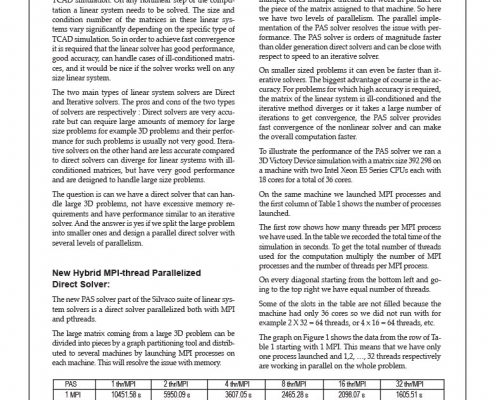
Performance Evaluation of a New Hybrid MPI-thread Parallelized Direct Solver
The solution of linear systems lies in the core of any TCAD simulation. On any nonlinear step of the computation a linear system needs to be solved. The size and condition number of the matrices in these linear systems vary significantly depending on the specific type of TCAD simulation. So in order to achieve fast convergence it is required that the linear solver has good performance, good accuracy, can handle cases of ill-conditioned matrices, and it would be nice if the solver works well on any size linear system.
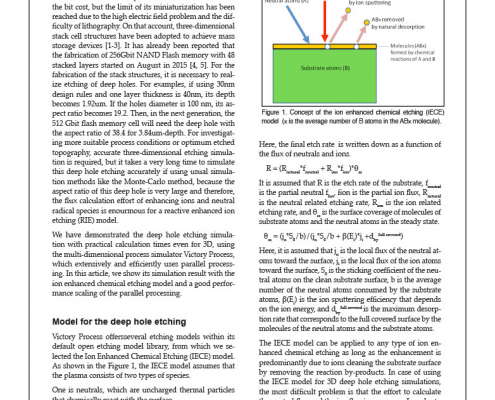
Deep Hole Etching Simulation for Advanced NAND Flash Memory
The NAND Flash memory cell has been refined to reduce the bit cost, but the limit of its miniaturization has been reached due to the high electric field problem and the difficulty of lithography. On that account, three-dimensional stack cell structures have been adopted to achieve mass storage devices [1-3]. It has already been reported that the fabrication of 256Gbit NAND Flash memory with 48 stacked layers started on August in 2015 [4, 5]. For the fabrication of the stack structures, it is necessary to realize etching of deep holes. For examples, if using 30nm design rules and one layer thickness is 40nm, its depth becomes 1.92um. If the holes diameter is 100 nm, its aspect ratio becomes 19.2. Then, in the next generation, the 512 Gbit flash memory cell will need the deep hole with the aspect ratio of 38.4 for 3.84um-depth. For investigating more suitable process conditions or optimum etched topography, accurate three-dimensional etching simulation is required, but it takes a very long time to simulate this deep hole etching accurately if using usual simulation methods like the Monte-Carlo method, because the aspect ratio of this deep hole is very large and therefore, the flux calculation effort of enhancing ions and neutral radical species is enourmous for a reactive enhanced ion etching (RIE) model.

Optical Simulation of Organic Light Emitting Diode by Transfer Matrix Method with a Green’s Function Approach and 2D FDTD
Organic light emitting diode (OLED) has been getting much attention over the past decades in the field of displays and lighting applications for its excellent efficiency, color quality and color tunability. Optical modeling of OLEDs is one important development issue to create high performance devices [1]. In this article, several optical simulations of OLEDs are presented by using recently implemented features in Atlas. First, we present the multiple dipole sources emission from a stacked layers structure, including the interference effect between the emitted light and reflected light using Transfer Matrix Method (TMM) with a Green’s Function Approach [2-4]. Then, we present the 2D FDTD analysis on the device with the grating structure using the finite difference time domain (FDTD) [5].
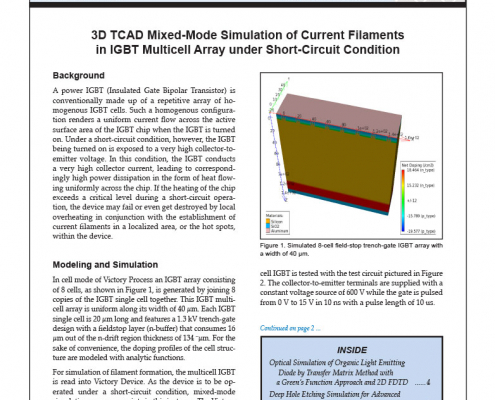
3D TCAD Mixed-Mode Simulation of Current Filaments in IGBT Multicell Array under Short-Circuit Condition
A power IGBT (Insulated Gate Bipolar Transistor) is conventionally made up of a repetitive array of homogenous IGBT cells. Such a homogenous configuration renders a uniform current flow across the active surface area of the IGBT chip when the IGBT is turned on. Under a short-circuit condition, however, the IGBT being turned on is exposed to a very high collector-to-emitter voltage. In this condition, the IGBT conducts a very high collector current, leading to correspondingly high power dissipation in the form of heat flowing uniformly across the chip. If the heating of the chip exceeds a critical level during a short-circuit operation, the device may fail or even get destroyed by local overheating in conjunction with the establishment of current filaments in a localized area, or the hot spots, within the device.
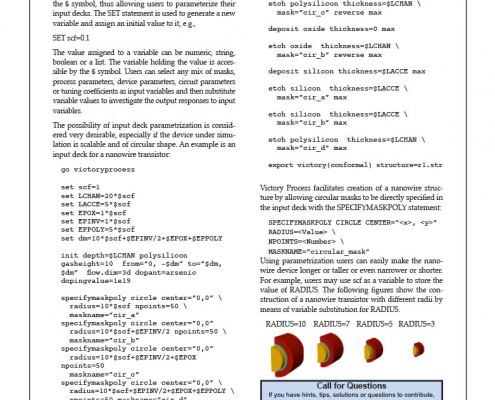
Hints, Tips and Solutions – Create scalable devices with Victory Process
Deckbuild supports variable substitution for both numerical and string variables using the SET statement and the $ symbol, thus allowing users to parameterize their input decks. The SET statement is used to generate a new variable and assign an initial value to it, e.g.,
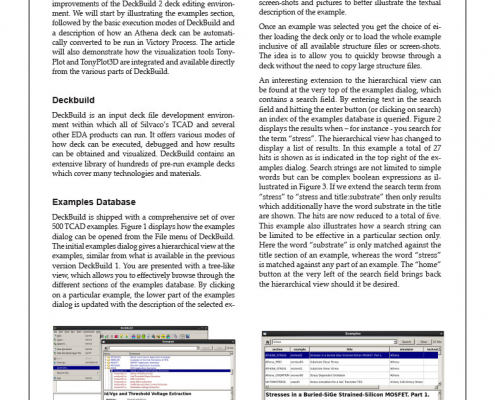
Improvements and Features of the Updated DeckBuild 2 GUI
In this article we will emphasize the new features and improvements of the DeckBuild 2 deck editing environment. We will start by illustrating the examples section, followed by the basic execution modes of DeckBuild and a description of how an Athena deck can be automatically converted to be run in Victory Process. The article will also demonstrate how the visualization tools TonyPlot and TonyPlot3D are integrated and available directly from the various parts of DeckBuild.
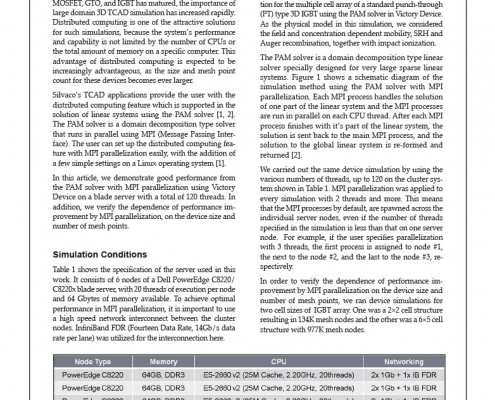
Performance Improvement by MPI Parallelization in 3D Device Simulation
As the design technology for power devices, such as MOSFET, GTO, and IGBT has matured, the importance of large domain 3D TCAD simulation has increased rapidly. Distributed computing is one of the attractive solutions for such simulations, because the system’s performance and capability is not limited by the number of CPUs or the total amount of memory on a specific computer. This advantage of distributed computing is expected to be increasingly advantageous, as the size and mesh point count for these devices becomes ever larger.
